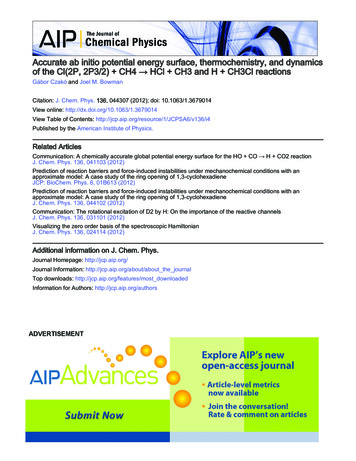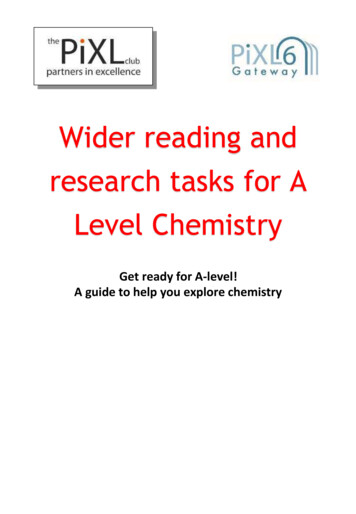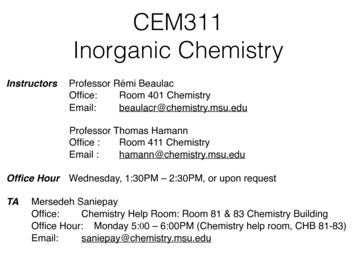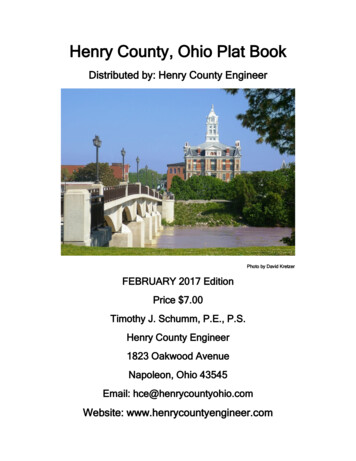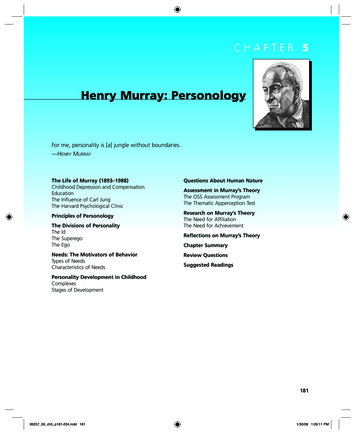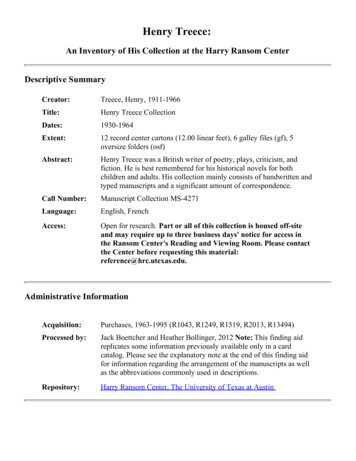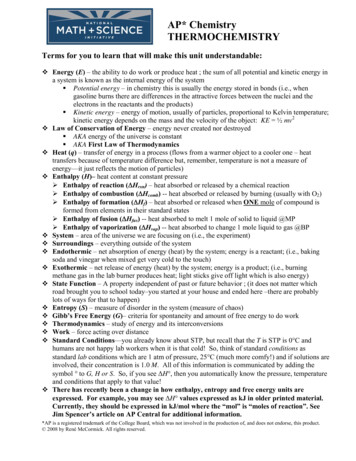
Transcription
AP* ChemistryTHERMOCHEMISTRYTerms for you to learn that will make this unit understandable: Energy (E) – the ability to do work or produce heat ; the sum of all potential and kinetic energy ina system is known as the internal energy of the system Potential energy – in chemistry this is usually the energy stored in bonds (i.e., whengasoline burns there are differences in the attractive forces between the nuclei and theelectrons in the reactants and the products) Kinetic energy – energy of motion, usually of particles, proportional to Kelvin temperature;kinetic energy depends on the mass and the velocity of the object: KE ½ mv2 Law of Conservation of Energy – energy never created nor destroyed AKA energy of the universe is constant AKA First Law of Thermodynamics Heat (q) – transfer of energy in a process (flows from a warmer object to a cooler one – heattransfers because of temperature difference but, remember, temperature is not a measure ofenergy—it just reflects the motion of particles) Enthalpy (H)– heat content at constant pressure¾ Enthalpy of reaction (ΔHrxn) – heat absorbed or released by a chemical reaction¾ Enthalpy of combustion (ΔHcomb) -- heat absorbed or released by burning (usually with O2)¾ Enthalpy of formation (ΔHf) – heat absorbed or released when ONE mole of compound isformed from elements in their standard states¾ Enthalpy of fusion (ΔHfus) -- heat absorbed to melt 1 mole of solid to liquid @MP¾ Enthalpy of vaporization (ΔHvap) -- heat absorbed to change 1 mole liquid to gas @BP System – area of the universe we are focusing on (i.e., the experiment) Surroundings – everything outside of the system Endothermic – net absorption of energy (heat) by the system; energy is a reactant; (i.e., bakingsoda and vinegar when mixed get very cold to the touch) Exothermic – net release of energy (heat) by the system; energy is a product; (i.e., burningmethane gas in the lab burner produces heat; light sticks give off light which is also energy) State Function – A property independent of past or future behavior ; (it does not matter whichroad brought you to school today–you started at your house and ended here –there are probablylots of ways for that to happen) Entropy (S) – measure of disorder in the system (measure of chaos) Gibb’s Free Energy (G)– criteria for spontaneity and amount of free energy to do work Thermodynamics – study of energy and its interconversions Work – force acting over distance Standard Conditions—you already know about STP, but recall that the T is STP is 0 C andhumans are not happy lab workers when it is that cold! So, think of standard conditions asstandard lab conditions which are 1 atm of pressure, 25 C (much more comfy!) and if solutions areinvolved, their concentration is 1.0 M. All of this information is communicated by adding thesymbol to G, H or S. So, if you see ΔH , then you automatically know the pressure, temperatureand conditions that apply to that value! There has recently been a change in how enthalpy, entropy and free energy units areexpressed. For example, you may see ΔH values expressed as kJ in older printed material.Currently, they should be expressed in kJ/mol where the “mol” is “moles of reaction”. SeeJim Spencer’s article on AP Central for additional information.*AP is a registered trademark of the College Board, which was not involved in the production of, and does not endorse, this product. 2008 by René McCormick. All rights reserved.
ENERGY AND WORK¾ See definition of energy.¾ ΔE q(heat) w(work)¾ Signs of q q if heat absorbed –q if heat released¾ Signs of w (commonly related to work done by or to gases) w if work done on the system (i.e., compression) w if work done by the system (i.e., expansion)¾ When related to gases, work is a function of pressure¾ (pressure is force per unit of area) and Δvolumew PΔVNOTE: Energy is a state function. (Work and heat are not.)Exercise 1Internal EnergyCalculate E for a system undergoing an endothermic process in which 15.6 kJ of heat flows andwhere 1.4 kJ of work is done on the system.17.0 kJExercise 2PV WorkCalculate the work associated with the expansion of a gas from 46 L to 64 L at a constant externalpressure of 15 atm.‒270 L atmThermochemistry2
Exercise 3Internal Energy, Heat, and WorkA balloon is being inflated to its full extent by heating the air inside it. In the final stages of thisprocess, the volume of the balloon changes from 4.00 106 L to 4.50 106 L by the addition of1.3 108 J of energy as heat. Assuming that the balloon expands against a constant pressure of1.0 atm, calculate E for the process. (To convert between L atm and J, use 1 L atm 101.3 J.)8.0 107 JENTHALPY Measure only the change in enthalpy, ΔH ( the difference between the potential energies of theproducts and the reactants) ΔH is a state function ΔH q at constant pressure (i.e.atmospheric pressure) (true most of the time for us and a veryhandy fact!) Enthalpy can be calculated from severalsources including: Stoichiometry Calorimetry From tables of standard values Hess’s Law Bond energies Stoichiometrically:Sample Problem A: Upon adding solid potassium hydroxide pellets to water the following reactiontakes place:KOH(s) KOH(aq) 43 kJ/molAnswer the following questions regarding the addition of 14.0 g of KOH to water:Does the beaker get warmer or colder?Is the reaction endothermic or exothermic?What is the enthalpy change for the dissolution of the 14.0 grams of KOH?Answers: (a) warmer (b) exothermic (c) 10.7 kJ/molThermochemistry3
Calorimetry:The process of measuring heat based on observing the temperature change when a body absorbsor discharges energy as heat.Types of calorimetry:(1) Coffee-cup calorimetry – in the lab this is how we experiment to find energyof a particular system. We use a Styrofoam cup, reactants that begin at thesame temperature and look for change in temperature. After all data iscollected (mass or volume; initial and final temperatures) we can use thespecific formula to find the energy released or absorbed. We refer to thisprocess as constant pressure calorimetry. ** q ΔH @ these conditions.**(2) Bomb calorimetry – weighed reactants are placed inside a steelcontainer and ignited. Often referred to as constant volume. This isused by industry to determine number of food calories that weconsume!Terms to know: Heat capacity – energy required to raise temp. by 1 degree (Joules/ C) Specific heat capacity (Cp) – same as above but specific to 1 gram of substancequantity of heat transferredspecific heat ( g of material) (degrees of temperature change) Molar heat capacity -- same as above but specific to one mole of substance(J/mol K or J/mol C ) Energy (q) released or gained at constant pressure: q mCpΔTq quantity of heat (Joules or calories)m mass in gramsΔT Tf - Ti (final – initial)Cp specific heat capacity ( J/g C) Specific heat of water (liquid state) 4.184 J/g C ( or 1.00 cal/g C)Water has one of the highest specific heats known! That is why the earth stays at such an eventemperature all year round! Cool huh? Heat lost by substance heat gained by water(if this does not happen, calculate the heat capacity of the substance)Thermochemistry4
Units of Energy: calorie--amount of heat needed to raise the temp. of 1.00 gram of water 1.00 C kilocalorie--duh!; the food calorie with a capital C.1kg mKE mv 2 units are2s2 joule--SI unit of energy; 1 cal 4.184 JSample Problem B:In a coffee cup calorimeter, 100.0 mL of 1.0 M NaOH and 100.0 mL of 1.0 M HCl are mixed. Bothsolutions were originally at 24.6 C. After the reaction, the final temperature is 31.3 C. Assumingthat all solutions have a density of 1.0 g/cm3 and a specific heat capacity of 4.184 J/g C, calculatethe enthalpy change for the neutralization of HCl by NaOH. Assume that no heat is lost to thesurroundings or the calorimeter.‒5.6 kJ/molExercise 4EnthalpyWhen 1 mole of methane (CH4) is burned at constant pressure, 890 kJ/mol of energy is released asheat. Calculate H for a process in which a 5.8-g sample of methane is burned at constant pressure. H heat flow ‒320 kJ/molThermochemistry5
Exercise 5Constant-Pressure CalorimetryWhen 1.00 L of 1.00 M Ba(NO3)2 solution at 25.0 C is mixed with 1.00 L of 1.00 M Na2SO4 solutionat 25 C in a calorimeter, the white solid BaSO4 forms and the temperature of the mixture increases to28.1 C. Assuming that the calorimeter absorbs only a negligible quantity of heat, that the specific heatcapacity of the solution is 4.18 J/ C g, and that the density of the final solution is 1.0 g/mL, calculatethe enthalpy change per mole of BaSO4 formed.‒26 kJ/molExercise 6Constant-Volume CalorimetryIt has been suggested that hydrogen gas obtained by the decomposition of water might be a substitutefor natural gas (principally methane). To compare the energies of combustion of these fuels, thefollowing experiment was carried out using a bomb calorimeter with a heat capacity of 11.3 kJ/ C.When a 1.50-g sample of methane gas was burned with excess oxygen in the calorimeter, thetemperature increased by 7.3 C. When a 1.15-g sample of hydrogen gas was burned with excessoxygen, the temperature increase was 14.3 C. Calculate the energy of combustion (per gram) forhydrogen and methane.Methane 55 kJ/gHydrogen 141 kJ/gThermochemistry6
Tables: ΔHf enthalpy of formation. Production of ONE mole of compound FROMits ELEMENTS in their standard states ( ) ZERO (0.00) for ELEMENTS in standard states Standard States: 25 C (298 K), 1 atm, 1MThe “Big Mamma” Equation: ΔHrxn Σ ΔHf (products) - Σ ΔHf (reactants)(also known as Hess’s Law)Sample Problem C: Calculate the ΔH rxn for the following:3 Al(s) 3 NH4ClO4(s) Al2O3(s) AlCl3(s) 3 NO(g) 6 H2O(g)Given the following (g)ΔHf (kJ/mol)-295-1676-70490.0-242‒2,677 kJ/mol (exo)Thermochemistry7
Sample Problem DSometimes all values are not found in the table of thermodynamic data. For most substances it isimpossible to go into a lab and directly synthesize a compound from its free elements. The heat offormation for the substance must be found by working backwards from its heat of combustion.Find the ΔHf of C6H12O6(s) from the following information:C6H12O6(s) 6 O2(g) 6 CO2(g) 6 H2O(l) 2800 kJSubstanceΔHf (kJ/mol)CO2(g)-393.5H2O(l)-285.8ΔHf ‒1276 kJ/mol for glucoseExercise 10Using enthalpies of formation, calculate the standard change in enthalpy forthe thermite reaction:2A1(s) Fe2O3(s) A12O3(s) 2Fe(s)This reaction occurs when a mixture of powdered aluminum and iron(III)oxide is ignited with a magnesium fuse.‒850. kJ/molThermochemistry8
Hess’s LawEnthalpy is not dependent on the reaction pathway. If you can find a combination of chemicalequations that add up to give you the desired overall equation, you can also sum up the ΔH’sfor the individual reactions to get the overall ΔHrxn.Remember this: First decide how to rearrange equations so reactants and products are on appropriatesides of the arrows. If equations had to be reversed, reverse the sign of ΔH If equations had be multiplied to get a correct coefficient, multiply the ΔH by thiscoefficient since ΔH’s are in kJ/MOLE (division applies similarly) Check to ensure that everything cancels out to give you the exact equation youwant. Hint** It is often helpful to begin your work backwards from the answer that youwant!Sample Problem F: Given the following equationsH3BO3(aq) HBO2(aq) H2O(l)ΔHrxn -0.02 kJ/molH2B4O7(aq) H2O(l) 4 HBO2(aq)Δ Hrxn -11.3 kJ/molH2B4O7(aq) 2 B2O3(s) H2O(l)Δ Hrxn 17.5 kJ/molfind the ΔH for this overall reaction2 H3BO3(aq) B2O3(s) 3 H2O(l)14.4 kJ/mol endothermicThermochemistry9
Bond Energies Energy must be added/absorbed to BREAK bonds (endothermic). Energy is releasedwhen bonds are FORMED (exothermic). This is a giant misconception amongstudents! Once again, it “takes” energy to break bonds and energy is released when abond forms. ΔH sum (Σ) of the energies required to break old bonds (positive signs since energy isadded to the system) plus the sum of the energies released in the formation of newbonds (negative signs since energy is lost from the system).ΔH Σ Bond Energies broken – Σ Bond Energies formedSample Problem G:Using bond energies, calculate the change in energy that accompanies the following reaction:H2(g) F2(g) 2 HF(g)Bond TypeH HF FH FBond Energy432 kJ/mol154 kJ/mol565 kJ/mol 544 kJ/mol SUMMARY FOR ENTHALPY: What does it really tell you about an equation? ΔH reaction is endothermic and heat energy is added into the system ΔH reaction is exothermic and heat energy is lost from the system (favored – naturetends toward the lowest energy state)Thermochemistry10
When a 1.50-g sample of methane gas was burned with excess oxygen in the calorimeter, the temperature increased by 7.3 C. When a 1.15-g sample of hydrogen gas was burned with excess oxygen, the temperature increase was 14.3 C. Calculate the energy of combustion (per gram) for hydrogen and methane. Methane 55 kJ/g Hydrogen 141 kJ/g

